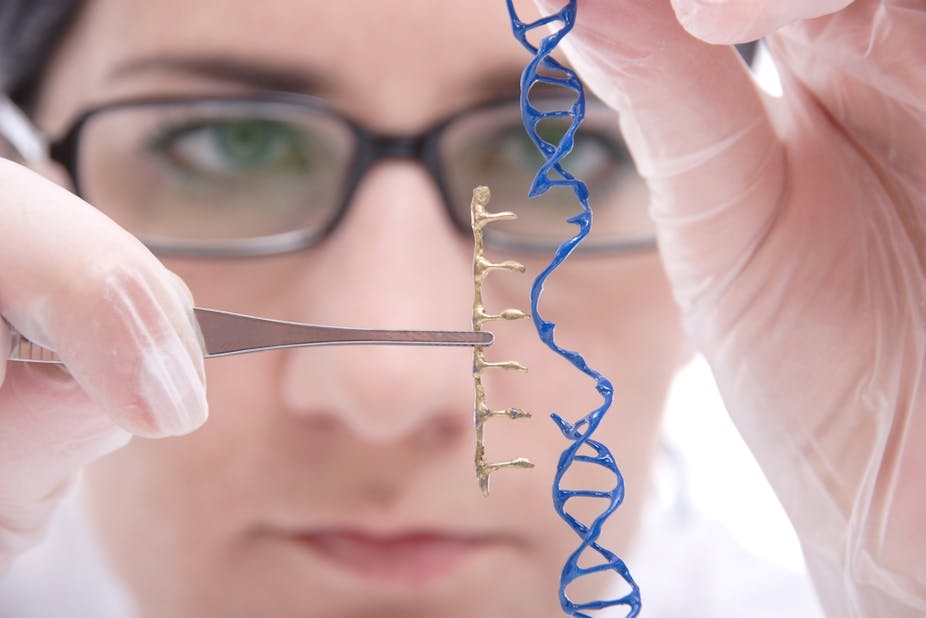Gene therapy is the ultimate comeback kid. A few weeks ago, it celebrated 25 years since the first trial in humans. Nobody cared. But when it was recently announced that a new type of gene therapy - only ever tested on mice - had been used to treat 17-month-old Layla Richards’ leukaemia, everybody cared.
Given its huge potential, the passing of the anniversary with so little media coverage emphasises its stormy passage over the last quarter of a century.
Replacing faulty genes
Many human diseases, including cancer, are caused by defects that occur in the genes within our cells. Genes are the blueprints that allow cells to make the proteins that control how they function. A mutation to a gene can either change a protein so that it no longer works as it should or the protein is not made at all.
Gene therapy attempts to treat disease by correcting the defective gene or genes. It has been proposed as a treatment for a wide range of diseases including cancer, cystic fibrosis, haemophilia and Parkinson’s disease.
It is relatively easy to make a healthy gene in the laboratory. The problem is that the healthy gene needs to be delivered to the affected cells without causing problems for the patient.
Early gene therapy focused on replacing the patient’s defective gene with a healthy copy. This was achieved by using a harmless virus, a “viral vector”, to deliver the healthy genes to the patient’s cells. That was the idea, anyway. The big problem is targeting the gene to a safe location within the recipient cell. If it goes in the wrong place then the cell can be damaged.
From glorious potential to disaster
In 1999, the promise of using replacement genes to cure disease lay in tatters – just nine years after gene therapy began – after 18-year-old volunteer Jessie Gelsinger died from multiple organ failure following a trial at the University of Pennsylvania. The exact cause of the Gelsinger’s death is still a mystery, but the expert opinion is that his immune system overreacted to the viral vector.
This tragic incident was a wake up call for scientists who had been caught up in the hype surrounding gene therapy and its perceived simplicity.
Further problems were to follow. In 2003, a French patient being treated for an immune system disorder, developed a leukaemia-like condition as a direct result of the treatment. The viral vector mistakenly delivered a replacement gene into a healthy gene, called LMO-2, which caused some cells to malfunction. This gene has been linked to a number of childhood cancers.
This disaster led to a moratorium on gene therapy trials.
Renewed optimism
Despite the setbacks, scientists and doctors have been slowly rebuilding the reputation of gene therapy and there is now a renewed optimism. Careful regulation of clinical trials involving gene therapy and improved gene technology that can silence overactive genes or repair – rather than replace them – has revitalised the field.
New gene editing technologies such as CRISPR and TALEN can be used to perform precision microsurgery on defective genes. This was demonstrated with the recent application of TALEN gene editing to treat Layla Richards’ leukaemia at Great Ormond Street Hospital in London – the first time a gene editing technology had been used in a human. And the results appear to be almost miraculous. But, if history has taught us anything, it’s the need to be cautiously optimistic.

However, there is a real possibility that this particular case could be the breakthrough that gene therapy scientists and patients have been waiting for because Layla’s genes are being subtly altered rather than totally replaced. Ultimately, it will be the accuracy of these new gene editing technologies in targeting precise genetic alterations to a cell’s genes that will determine their future in the treatment of diseases such as cancer.
The targeting of genes within cells using this technology is certainly a huge advance on earlier techniques, with their random placement of genes and devastating consequences. However, there is evidence to suggest that changes to genes elsewhere in the cell – genes that aren’t the target of the therapy – does occur with these new editing methods, but its hard to predict the frequency or say where and what the effects will be. In the end, it will be the extent of this deviation from the target gene site that will decide the technology’s fate and that of the patients undergoing treatment.
Eye-watering cost
Interest in gene therapy is going to increase in the next 10 to 20 years. One reason for this is the potential return on investment for biotechnology companies. A recently licensed European gene therapy treatment came with an eye-watering price tag of around €1m per patient.
Other treatments currently in development have projected costs of around US$1m per patient. These record breaking treatment costs may be explained by the small number of patients diagnosed with the diseases for which the treatments were designed and the fact that gene therapy is typically thought of as a “once only” treatment.
The high costs of a particular gene therapy will likely persist until the patent protecting the invention expires or someone comes up with a different therapy for the same disease and the competition drives the price down.
However, biotech companies need to carefully consider how they price such technologies as extortionate fees will undoubtedly be fought by healthcare providers and patient-groups alike. Bad publicity surrounding prohibitively expensive treatments, especially for rare diseases in children, can be very damaging to a company’s reputation.
As gene therapy looks forward to the next 25 years, there is a lot to be optimistic about, but unless the cost of treatment falls, gene therapy could remain as rare as the diseases it treats.

